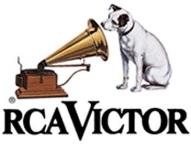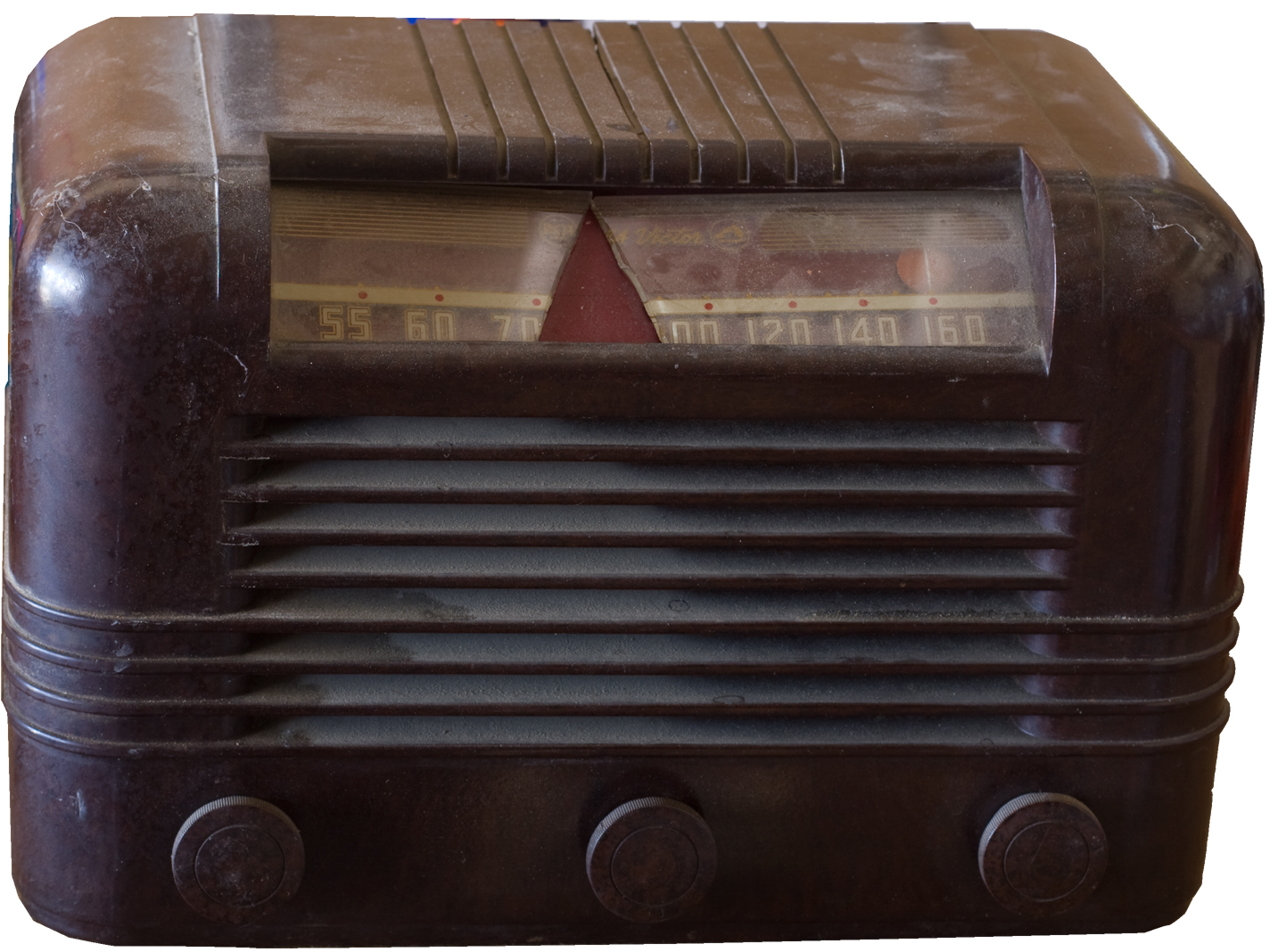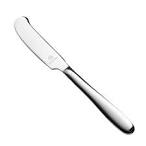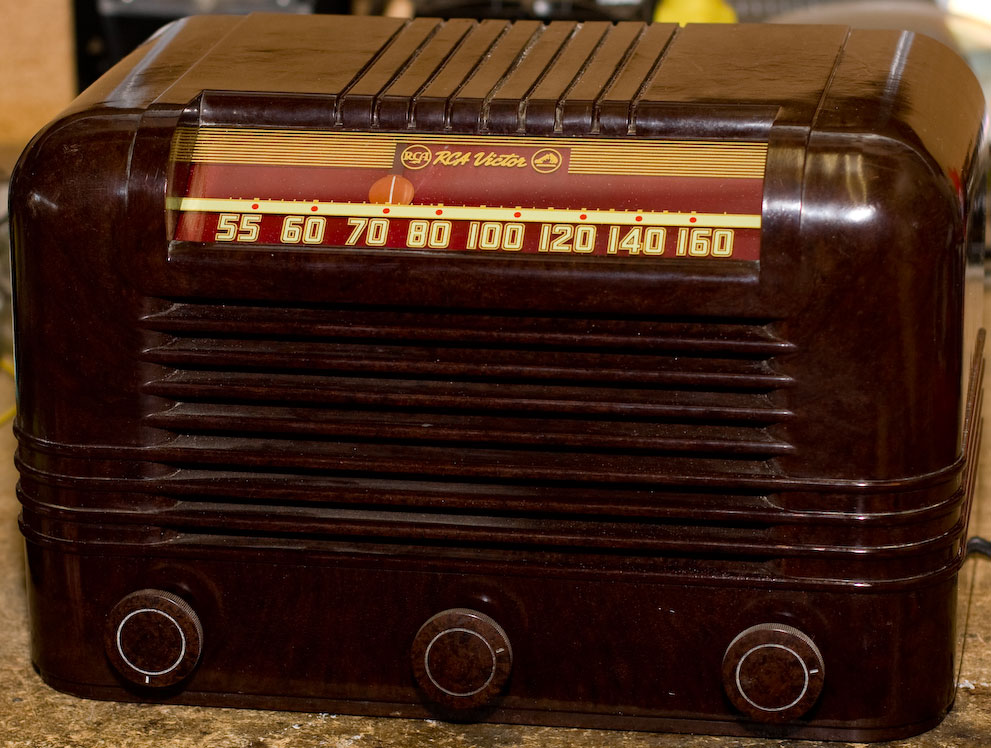
This is no longer in my collection; it is here for archival purposes only.
A table radio the Old Man had that he gave me, along with a box of others including the 65X1. It's a table radio in late art-deco style with a plastic body, circa 1946. It appears in Volume 15 of Rider's Perpetual Troubleshooter's Manual, RCA Page 15-26 and 15-31. It's an all-american five plus a separate local oscillator tube.
Tube Compliment
12SG7 - Converter
12J5 - local oscillator
12SK7 - IF
12SQ7 - 2nd detector
35L6 - Audio out
35Z5 - Rectifier
Dial lamp: #51
The third knob (far right side on the photo) is a tone control that simply switches in (or out) a 0.0018 µF cap.
 This radio was out in The Old Man's garage when something fell and landed on the top of it, cracking the cabinet top and breaking the dial glass. After that it sat for years and collected dust (literally). Now I've got it and I thought I'd try to make it worthy of being in the house again.
This radio was out in The Old Man's garage when something fell and landed on the top of it, cracking the cabinet top and breaking the dial glass. After that it sat for years and collected dust (literally). Now I've got it and I thought I'd try to make it worthy of being in the house again.
I thought this was going to be easy, but the wheels fell off almost immediately. First off, the dial glass. Radiodaze has one (I think it's a preproduction) for $32.95. I don't want to knock them because I'm glad they offer hard-to-find parts; it's just more than I want to pay for it (about three times as much). John Kendall's Vintage Electronics lists one for $15 but it's out of stock. I haven't been able to find one anywhere else.
In the meantime I thought I'd try to glue the broken one together. I thought I had all the pieces but I'm missing a couple. Loctite's glass glue appears to be plain old super glue. It says it dries invisibly but not quite. I glued as much as I could together and it looks like a plate of glass that's been glued back together—with pieces missing.
I tried the radio first and was pleased to see that it played, so I had hoped that the dial glass and the cabinet crack would be the only things to do. But I took the chassis out (had to in order to get to the glass), turned it on again and immediately the dial lamp blew. According to the RCA docs in Rider's PTM, the dial lamp is a #51. Do I have one? No. Nobody local has it; I'll have to mail order it. Bob's Antique Radios sells them for a reasonable price; I just wish he had other stuff I wanted so I could combine the orders.
Just for fun I looked at the dead one and saw that it was #47, probably put there by The Old Man because he didn't have a 51 either. I stuck a 47 in for the time being. (A #51 is 7.5V @ 200mA, a #47 is 6.3V at 150mA).
But there was also another problem—the audio is almost gone. I can barely hear one of the strong local stations. I pulled the tubes and tested them. The 12SG7 fails the shorts test on all three of my testers. Do I have a 12SG7? No. Can I get one locally? There's a local electronics swap meet that meets once a month in a high school parking lot. Last weekend. I'll have to mail order this one as well.
In the mean time, maybe I can rob another radio and try it. Do I have one? No. I could put in a 6SG7 if I want to bodge in a dropping resistor, but it's an inexpensive tube and I don't really want to do that unless I'm desperate, and I'm not.
So electrically, I'm dead in the water until the mailman delivers things that glow in the dark.
While I waited for the tube and the bulb, I thought I'd see what I could do with the cabinet. At first I figured it was vinyl or some other post-WW2 plastic, but when I really looked at it I realized it was catalin. It's not just brown, it's got a fine marbling to it. I've got some other catalin-cased things, and while this is more conservatively colored, it's definitely the same thing.
Awesome took off the top layer of dirt but getting the grime out of the nooks and crannies is taking some work. I'd like to give it a bath in warm soapy water but there's half an original label on the underside and I don't want to destroy it, so instead I'm just going over it in panels and trying to keep the bottom dry.
Catalin, unfortunately, can get really scuffed and dull over time and bringing it back is a chore. I started with Meguiar's plastic polish but that didn't do much, then cleaner wax. After that I checked the net, and the consensus seems to be to use metal polish. Radiolaguy suggests Blue Magic, which I don't have, but I do have a tube of Maas Metal Polish and a can of Eagle 1 Nevr Dull, which is a big wad of rag batting that's soaked in the polish, so you just pull off a chunk of batting and start scrubbing. I only tried a little of the Maas but I like the Nevr Dull seems to work fairly well, and I like the convenience, since I use a separate clean rag to buff. The improvements aren't fast and obvious, but coming in slowly. I'll photograph the cabinet again when it's done.
Things made of glass arrived and I moved back to the chassis. Installed the new 51 lamp, and just in time as I burned out another 44. I blame the surge current when you turn the set on: you can see the bulb light, then dim alarmingly, then slowly build back up. I looked on the schematic to locate the surge resistor—there is no surge resistor.
Put the new SG7 and it made no difference; the radio isn't dead, it's just extremely weak. At full volume, one of the big three strong stations I receive could just barely be heard if you put your near next to the speaker and gave it your attention.
What happened next frustrates me beyond belief, and I'm writing this here because I said I'd be honest about what happens, good, bad and indifferent. What happened was a week of me poking around the chassis with my signal generator, trying to trace the problem and not being able to get consistent answers. Voltage checks came out normal, even a little high on the filaments. No opens that I could find. Every resistor I could find measured in the ballpark of what it was supposed to be. No obviously leaky capacitors. No accidental shorts from wires or joints dressed too close together.
 Finally, as I decided once again to try going backward through the stages, I dialed up AF on the signal generator and the hot end on the plate of the 35L6 audio tube. Fine. Now put it on the grid, which is Pin 4 and a bit buried. The generator's positive lead is an aligator clip, not a probe, but I've been doing it without problems. But this time I slip. A pop and a flash of light, and profanity was drowned out by the set coming to life and speaker rattling from being overdriven by the signal.
Finally, as I decided once again to try going backward through the stages, I dialed up AF on the signal generator and the hot end on the plate of the 35L6 audio tube. Fine. Now put it on the grid, which is Pin 4 and a bit buried. The generator's positive lead is an aligator clip, not a probe, but I've been doing it without problems. But this time I slip. A pop and a flash of light, and profanity was drowned out by the set coming to life and speaker rattling from being overdriven by the signal.
This is now the second project in a row where I've unintentionally fixed some ailment by accidentally shorting something, and not knowing for sure what it was that I did, and no idea why it worked. But now I'm thinking I should sell off my Rider books, the scope, the signal generator, the freq counter, all the meters and the alignment wands and all the other crap I've accumulated, and instead just plug it in, flip over the chassis, and flail around with a butter knife like shaking coins out of a piggy bank.
I had middling luck with the dial glass. It was broken roughly in half, and then one half had two smaller chunks broken off. I used regular super glue on the smaller pieces and they held. Loctite's Glass glue, however, never got passed gummy; it was almost like rubber cement. Eventually I cleaned it off and tried again with super glue. Unfortunately the break between the halves makes for too much stress in the middle, and it was never strong enough to hold without breaking again.
New Dial Glass
I don't date these things so I don't know how long it's been, but I know it's been years. After years of not knowing where to get a dial glass, after finding a dial glass and not wanting to pay their price for it, after around a year resigned to paying the price: I finally ordered one from Radio Daze. Like the one I got for my RCA console, it's expensive but it is a very nice glass; they do a great job.
Went over it with some headline lens cleaner, which is basically just plastic polish that's a little more aggressive than most, this looks pretty nice.
Current condition: no longer in my collection.

